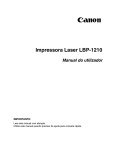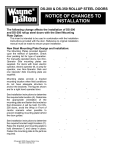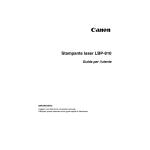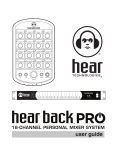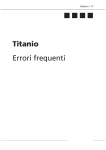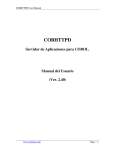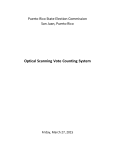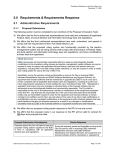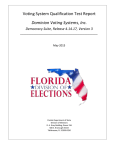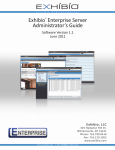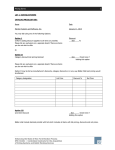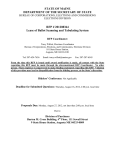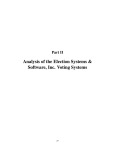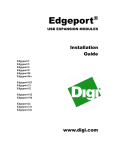Download Certification Test Report - Florida Department of State
Transcript
Voting System Qualification Test Report
Elections Systems & Software, LLC
EVS Release 4.5.0.0, Version 4
______________________________________________
April 2015
Florida Department of State
Division of Elections
R. A. Gray Building, Room 316
500 S. Bronough Street
Tallahassee, FL 32399-0250
Florida Department of State
Division of Elections
Voting System Qualification Test Report
ES&S EVS Release 4.5.0.0, Version 4
Contents
EXECUTIVE SUMMARY .................................................................................................................................... 3
INTRODUCTION............................................................................................................................................... 5
BACKGROUND ................................................................................................................................................ 5
SYSTEM OVERVIEW ......................................................................................................................................... 5
COMPONENT VERSION LIST ............................................................................................................................ 7
SOFTWARE.............................................................................................................................................................7
System Software ............................................................................................................................................7
HARDWARE..........................................................................................................................................................10
Election Management System Hardware ....................................................................................................10
Precinct Count Systems ................................................................................................................................11
Precinct Voter Assistance Devices ................................................................................................................12
Central / Absentee Count .............................................................................................................................13
Voting System Hardware .............................................................................................................................14
COMPONENTS UNDER REVIEW ..................................................................................................................... 15
CONDUCT OF TESTS / FINDINGS .................................................................................................................... 16
SYSTEMS SETUP & CONFIGURATION .........................................................................................................................16
PHYSICAL AUDIT ...................................................................................................................................................16
FUNCTIONAL SYSTEM AUDIT ...................................................................................................................................16
Voting Equipment Menus – Administrative and Diagnostic Reports ...........................................................16
Mock Elections .............................................................................................................................................17
Precinct Tabulator Mass Ballot Counts ........................................................................................................17
Accessibility – Sound Pressure Level ............................................................................................................20
Accessibility – Force .....................................................................................................................................21
Accessibility – Clearance Requirements .......................................................................................................23
Contest Recounts .........................................................................................................................................25
Modems .......................................................................................................................................................25
Regional Results Application........................................................................................................................25
Folded Ballot ................................................................................................................................................27
Scanner Sensitivity .......................................................................................................................................28
System Clock ................................................................................................................................................28
Battery Life ...................................................................................................................................................29
ExpressVote..................................................................................................................................................29
ExpressPass Printer / Bar Codes ...................................................................................................................38
Toolbox ........................................................................................................................................................42
SOURCE CODE REVIEW...........................................................................................................................................42
CONTINUOUS IMPROVEMENT & RECOMMENDATIONS ................................................................................ 42
CONCLUSION ................................................................................................................................................ 43
CERTIFICATION OF EVS RELEASE 4.5.0.0, VERSION 4 VOTING SYSTEM ............................................................................43
PROVISIONAL APPROVAL OF EXPRESSVOTE BALLOT MARKING DEVICE.............................................................................43
APPENDICES .................................................................................................................................................. 45
APPENDIX A – ACRONYMS ......................................................................................................................................45
APPENDIX B – APPLICATION TIMELINE TABLE .............................................................................................................46
FIGURES INDEX .....................................................................................................................................................47
TABLES INDEX.......................................................................................................................................................48
Page 2 of 49
Florida Department of State
Division of Elections
Voting System Qualification Test Report
ES&S EVS Release 4.5.0.0, Version 4
Executive Summary
Elections Systems & Software, LLC (ES&S) submitted an application requesting Florida certification of the
EVS Release 4.5.0.0, Version 4 voting system. ES&S’s request includes various optimization and
performance enhancements of previously certified systems, as well as the introduction of the ExpressVote
marking device.
The current Florida certified voting system includes an election management system known as
ElectionWare; a precinct scanner (DS200); a precinct ballot marking device that can be used by voters with
disabilities (AutoMARK); and a central count scanner (DS850). Precinct results may be uploaded to the
election management system manually, or via wireless or landline modems.
This certification introduces a new device to Florida voters with disabilities. The ExpressVote is a vote
capture device with a verifiable paper record that is digitally scanned for tabulation. This system combines
paper-based voting with touch screen technology. The ExpressVote includes a mandatory vote summary
screen that requires voters to confirm or revise their selections prior to printing the summary of ballot
selections using the internal thermal printer. Once printed, ES&S ballot scanners process the vote
summary card. The ExpressVote is designed to serve all voters, but the EVS Release 4.5.0.0, Version 4
application request is for use only by voters with disabilities. ES&S has fully integrated the ExpressVote
with the existing suite of ES&S voting system products.
The Division of Elections’ Bureau of Voting Systems Certification (BVSC) conducted the certification testing
in two phases. Phase I consisted of verifying the setup of the two configurations of the election
management system, restoration/import of two elections (general and primary elections), creation of two
elections (municipal and Presidential Preference Primary elections), a physical audit, and a functional
audit. Phase II encompassed the conduct of mock elections and election cycle events, such as loading the
tabulators with the requisite media, opening and closing of polls, feeding ballots, central count tabulation,
and election night and post-election reporting. BVSC performed tests to verify compliance with standards
for sound pressure levels and contest recounts, conducted mass ballot count testing for the central count
scanner and the precinct scanner, and conducted additional tests as necessary to observe the voting
system’s capabilities.
The ES&S ExpressVote represents new technology in a voting system specifically for use by Florida voters
with disabilities. For example, the system introduces a vote summary card (in lieu of a traditional ballot
card) upon which is imprinted only the voter’s selections in all contests on a ballot, all contest titles and a
corresponding barcode to be “read” by the tabulator. BVSC finds that with future enhancements, the
system could provide greater independence for persons with disabilities. However, in its current form,
BVSC has identified several areas affecting usability and functionality that warrant enhanced
documentation, procedures, training guidance, or refinements to the system.
The BVSC recommends certification of EVS Release 4.5.0.0, Version 4 voting system, and provisional
approval of the ExpressVote ballot marking device component, as follows:
1) Certification for EVS Release 4.5.0.0, Version 4 voting system, except for the ExpressVote
component, provided the vendor makes beforehand necessary changes to its written
Page 3 of 49
Florida Department of State
Division of Elections
Voting System Qualification Test Report
ES&S EVS Release 4.5.0.0, Version 4
documentation 1 to reflect BVSC recommendations for greater specificity, clarity, and guidance
regarding use of the system.
2) Provisional approval of the ExpressVote ballot marking device for use in any election conducted
through May 1, 2017, with the ExpressVote ballot marking device to be used solely by persons
with disabilities. The approval should be subject to the following conditions:
a. The vendor should make the necessary changes to its written documentation 2 to reflect
BVSC recommendations for greater specificity, clarity, and guidance regarding use of the
system.
b. The use of the ExpressVote ballot marking device, if approved, is also subject, before
use in any election, to future revisions to Rule 1S-2.032, F.A.C., to provide standards for
the accessible audio-visual onscreen display of the ballot and the printed vote summary
card in accordance with section 101.5608(3), Florida Statutes.
c. BVSC does not recommend an extension of this provisional approval, if granted, or
recommend the approval of any future release of this ExpressVote ballot marking device
unless the issues in the Continuous Improvements/Recommendations section of this
report are addressed or are no longer an issue.
1
ES&S has satisfactorily completed EVS Release 4.5.0.0. Version 4 manual updates/documentation
requirements.
2
ES&S has satisfactorily completed manual updates/documentation requirements as related to the
ExpressVote ballot marking device.
Page 4 of 49
Florida Department of State
Division of Elections
Voting System Qualification Test Report
ES&S EVS Release 4.5.0.0, Version 4
Introduction
Elections Systems & Software, LLC (ES&S) submitted an application requesting Florida certification of the
EVS Release 4.5.0.0, Version 4 voting system. ES&S’s request includes various optimization and
performance enhancements as well as the introduction of the ExpressVote marking device. The
ExpressVote is a voter interface device for voters with disabilities to be used at a polling location.
Background
ES&S’s ElectionWare voting system first received certification in the state of Florida on February 9, 2012,
for EVS Release 5.0.0.0, Version 2. On September 25, 2012, BVSC certified EVS Release 4.0.3.0, Version 2,
which included enhancements to the precinct and high-speed scanners of the voting system.
In January 2014, ES&S’s initial application for certification of EVS Release 4.5.0.0, Version 2 was deemed
to be complete. Through the subsequent review and testing process, the vendor made changes to the
scope of the application and necessary modifications to the system. The application, now in its seventh
iteration as EVS Release 4.5.0.0, Version 4, 3 includes optimization and performance enhancements
throughout the voting system.
System Overview
This is a paper-based voting system with an element for compliance with HAVA provisions for precinct
voting. The Florida certified voting system includes the Election Management System (EMS), a precinct
scanner, a central count scanner, and precinct voter interface devices that can be used by a voter with a
disability.
The EMS hardware platform is configured as either a stand-alone or a server/client configuration. The
stand-alone configuration includes the election management system and the election results reporting
manager; whereas, the server/client configuration includes one or more workstations (clients) which
interconnect with a server. The system includes an option to upload election results wirelessly or using an
analog (“landline”) modem.
The EMS software configuration includes:
•
ElectionWare – integrates the jurisdiction, districts, contests, and candidate database as the main prevoting phase and post-voting phase that allows ballot images to be viewed. Provides the method to
configure elections, create ballot design, add languages (including audio), export ballot/election
definitions and view ballot images.
•
Election Reporting Module (ERM) – a client application used for integrating election results
acquisition, consolidation, and reporting. A second ERM client can be configured as a distribution
system to display scrolling results on-screen and over the Intranet.
•
The ballot-marking equipment includes the ExpressVote and AutoMARK voter assist terminal (VAT).
The tabulating voting equipment includes the DS200 and the DS850.
3
See Appendix B – Application Timeline Table
Page 5 of 49
Florida Department of State
Division of Elections
Figure 1. ExpressVote
Voting System Qualification Test Report
ES&S EVS Release 4.5.0.0, Version 4
The ExpressVote is a vote capture device with a verifiable paper record
that is digitally scanned for tabulation. This system combines paper-based
voting with touch screen technology, and integrates assistive peripherals
such as headphones, tactile keypad, sip and puff device, or rocker/paddle
control switch. The ExpressVote includes a mandatory vote summary
screen that requires voters to confirm or revise selections prior to printing
the summary of ballot selections using the internal thermal printer. Once
printed, ES&S ballot scanners process the vote summary card. ES&S has
fully integrated the ExpressVote with the existing suite of ES&S voting
system products.
Figure 2. AutoMARK
The AutoMARK Voter Assist Terminal (VAT) is a voter interface device that
allows a voter to mark a blank, preprinted paper ballot or assists a voter
with contest selections via visual display, audio, or both. The voter uses the
AutoMARK to navigate the ballot utilizing the touchscreen, physical
keypad, and assistive support peripherals such as a sip and puff device or
other assistive equipment. Also, the voter can use the AutoMARK to review
a marked ballot and either to cast the ballot into an optical scan tabulator
(like the DS200) or, if available, to cast the ballot into an attached ballot
box, known as the AutoCast.
Figure 3. DS200
The DS200 is a voter interface device used to scan paper ballots. It is a
precinct tabulator that can also be used to scan absentee ballots. This
tabulator captures the voter’s selections and digitally images the ballot.
The DS200 uses a USB 4 drive for downloading the election definition,
provides an option to capture cast ballot images on the USB, and provides
the election results on the USB. The results data can then be manually
uploaded into ERM, or the DS200 can transmit via secure wireless telecom
network into ERM.
Figure 4. DS850
The DS850 optical tabulator is a high-speed scanner for use to scan
absentee ballots or to conduct machine recounts of contests/races. The
DS850 uses digital cameras to image paper ballots, capture voter selections
on the image, and evaluate the results. It uses a USB drive for downloading
the election definition, captures the cast ballot images on the USB, and
provides the results on the USB. The results data are uploaded into ERM
either via the USB or via an Ethernet connection. The DS850 also uses two
COTS printers, one for printing reports and the other for recording and
printing an audit log.
4
The DS200, DS850, and ExpressVote use Delkin brand, ES&S qualified, USB flash drives.
Page 6 of 49
Florida Department of State
Division of Elections
Voting System Qualification Test Report
ES&S EVS Release 4.5.0.0, Version 4
Component Version List
The component version list describes in detail the components of the voting system under test.
Software
The software applications that comprise the voting system are listed below:
•
Event Log Service (ELS) version 1.5.4.0
•
Removable Media Service (RMS) version 1.4.4.0
•
ElectionWare (EW) version 4.5.0.0
•
AutoMARK VAT Previewer version 1.8.5.0
•
ExpressVote Previewer version 1.2.3.0
•
Election Reporting Manager (ERM) version 8.10.0.0
•
Optional: Regional Results version 1.1.0.0
•
Optional: ExpressPass version 1.0.0.0
System Software
The system’s software requirements are in the table below.
Table 1. Election Management System software requirements
Product
Software/Firmware
Version
Manufacturer
Description
EMS Workstation or Standalone Configuration - Required for all EMS components
Windows Operating
System
Windows 7
Professional-SP1
Microsoft
Operating System
Microsoft Offline
Updates
8.6
WSUS
Offline operating system
updates for security, etc.
Symantec Endpoint
Protection
Small Business
Edition (2013)
Symantec
Anti-Virus
Adobe Acrobat Standard
XI (11.0)
Adobe
Ballot PDF generation
RMCOBOL
12.06
Liant
COBOL Runtime
Removable Media
Service (RMS)
1.4.4.0
ES&S
Supports graceful
installation and removal of
media
ES&S Event Log Service
(UELS)
1.5.4.0
ES&S
Provides custom event log
reports from the Windows
Event Log
VAT Previewer
1.8.5.0
ES&S
View on-screen display of
the AutoMARK in EMS
ExpressVote Previewer
1.2.3.0
ES&S
View on-screen display of
the ExpressVote in EMS
Page 7 of 49
Florida Department of State
Division of Elections
Voting System Qualification Test Report
ES&S EVS Release 4.5.0.0, Version 4
Product
Software/Firmware
Version
Manufacturer
Description
Election Reporting
Manager (ERM)
8.10.0.0
ES&S
Election results reporting
manager
ElectionWare – Client
4.5.0.0 (Client)
ES&S
Election database, ballot
and election equipment
configuration
ElectionWare – All
Components
4.5.0.0 (Standalone)
ES&S
For Standalone only –
installs the Postgres
database and
ElectionWare client
EMS Server - Required for EMS server
Windows Operating
System
Server 2008 R2
Standard Edition
Microsoft
Operating System
Microsoft Offline
Updates
8.6
WSUS
Offline operating system
updates for security, etc.
Symantec Endpoint
Protection
Small Business
Edition (2013)
Symantec
Anti-Virus
Cereberus FTP
(Optional)
6.0.7.1
Cereberus
Secure, FTP server for
DS850 file transfer
RMCOBOL
12.06
Liant
COBOL Runtime
Removable Media
Service (RMS)
1.4.4.0
ES&S
Supports graceful
installation and removal of
media
ES&S Event Log Service
(UELS)
1.5.4.0
ES&S
Provides custom event log
reports from the Windows
Event Log
ElectionWare – Server
4.5.0.0
ES&S
Installs the Postgres
database
Network Results Server (Optional) - Results Server for Modeming Support
Windows Operating
System
Server 2008
R2 Standard
Edition
Microsoft
Operating System
Microsoft Offline
Updates Symantec
8.6
WSUS
Offline operating system
updates for security, etc.
Endpoint Protection
Small Business
Edition (2013)
Symantec
Anti-Virus
Cerberus FTP
6.0.7.1
Cerberus LLC
Secure, FTP server
Network Results Client (Optional) - Results Client for Modeming Support
Windows Operating
System
Windows 7
Professional-SP1
Microsoft
Operating System
Microsoft Offline
Updates
8.6
WSUS
Offline operating system
updates for security, etc.
Page 8 of 49
Florida Department of State
Division of Elections
Voting System Qualification Test Report
ES&S EVS Release 4.5.0.0, Version 4
Product
Software/Firmware
Version
Manufacturer
Description
Symantec Endpoint
Protection
Small Business
Edition (2013)
Symantec
Anti-Virus
Adobe Acrobat Standard
XI (11.0)
Adobe
PDF reader for software
help guides
IPSwitch WS_FTP
12.4.1
IPSwitch
Secure, FTP server
Election Reporting
Manager (ERM)
8.10.0.0
ES&S
Processes tabulated results
from DS200/DS850
Regional Results (Optional) - Regional Results Client for network environment
Windows Operating
System
Windows 7
Professional-SP1
Microsoft
Operating System
Microsoft Offline
Updates
8.6
WSUS
Offline operating system
updates for security, etc.
Symantec Endpoint
Protection
Small Business
Edition (2013)
Symantec
Anti-Virus
Adobe Reader XI
XI (11)
Adobe
PDF reader to access the
help guide
ES&S Regional Results
1.1.0.0
ES&S
ES&S Software Application
Vendor Wireless Hot
Spots
Jetpack 4G LTE
Verizon
Netgear Zing
Sprint
Optional Wireless Hotspot
for regional results
transmission
4G LTE
AT&T
USB551L
Verizon
Netgear 341U
Sprint
Netgear 340U
AT&T
Vendor Broadband
Modems
Optional Broadband
Modems for regional results
transmission
ExpressPass (Optional) - ExpressPass Workstation
Windows Operating
System
Windows 7
Professional-SP1
Microsoft
Operating System
Microsoft Offline
Updates
8.6
WSUS
Offline operating system
updates for security, etc.
Symantec Endpoint
Protection
Small Business
Edition (2013)
Symantec
Anti-Virus
Adobe Reader XI
XI (11)
Adobe
PDF reader to access the
help guide
ES&S ExpressPass
1.0.0.0
ES&S
ES&S Software Application
ExpressPass Printer
Model 402
Microcom
ExpressPass printer to print
activation cards
Page 9 of 49
Florida Department of State
Division of Elections
Voting System Qualification Test Report
ES&S EVS Release 4.5.0.0, Version 4
Hardware
The hardware components of the voting system are listed and described below.
Election Management System Hardware
The Election Management System hardware requirements are in the table below.
Table 2. Election Management System hardware requirements
Product
Version
Manufacturer
Description
EMS Workstation - PC workstation for Network Configuration
Processor
Dual Core
N/A
RAM
2GB minimum, 4GB
recommended
N/A
Hard Disk
150GB
N/A
Keyboard
Standard Keyboard
N/A
Mouse
Standard Mouse
N/A
Monitor
1048x768 minimum
resolution
N/A
CD/DVD reader
16x or faster
N/A
USB Ports
Minimum of (2) USB
2.0 ports
N/A
Ethernet Port
Available LAN
connection
N/A
Report Printer
Standard Printer
N/A
Suggested network
switch to connect to EMS
server
Gigabit Switch
DGS-1008G
D-Link
EMS Server - Host system for Windows Server configurations
Processor
Quad Core
N/A
RAM
4GB minimum
N/A
Hard Disk
320GB
N/A
Keyboard
Standard Keyboard
N/A
Mouse
Standard Mouse
N/A
Monitor
1048x768 minimum
resolution
N/A
CD/DVD reader
16x or faster
N/A
USB Ports
Minimum of (2) USB
2.0 ports
N/A
Ethernet Port
Available LAN
connection
N/A
Report Printer
Standard Printer
N/A
Network Results Server - Host system for network results server configuration
Processor
Quad Core
N/A
RAM
4GB minimum
N/A
Hard Disk
320GB
N/A
Keyboard
Standard Keyboard
N/A
Page 10 of 49
Florida Department of State
Division of Elections
Voting System Qualification Test Report
ES&S EVS Release 4.5.0.0, Version 4
Product
Version
Manufacturer
Mouse
Standard Mouse
N/A
Monitor
1048x768 minimum
resolution
N/A
CD/DVD reader
16x or faster
N/A
USB Ports
Minimum of (2) USB
2.0 ports
N/A
Ethernet Port
Available LAN
connection
N/A
Report Printer
Standard Network
Printer
N/A
Rapidport/4
Digi Rapidport/4 USB
to 4-port Modem
Digi
Network Security Device
ASA 5505 Security
Appliance
Cisco
Description
Precinct Count Systems
The precinct count scanner is the DS200.
Digital Scan 200 (DS200)
•
DS200 Hardware Revision 1.2, 1.2.3.0, 1.3
o
•
•
DS200 Hardware v. 1.2.3.0 is equivalent to HW 1.2 plus ECOs 5 1158, 1160, 1281, 1346,
1398, 1400 (Approved by BVSC on 7/31/13)
Firmware version 2.11.0.3
o
Scanner Firmware v. 3.0.0.0
o
Power Management Firmware v. 1.2.10.0
Auxiliary equipment for DS200
o
Plastic Ballot Box (HW Revision 1.2, 1.3, 1.4)
•
o
Steel Ballot Box (With or without diverter)
o
Plastic DS200 Tote Bin
USB Memory Device (Media) for DS200
o
•
5
Delkin USB (512MB, 1GB, 2GB, 4GB, 8GB)
Compact Flash Memory Device (Internal) for DS200
o
•
Plastic Ballot Bin HW v. 1.4 is equivalent to HW 1.3 plus ECOs 1251, 1266, 1351,
1388 (Approved by BVSC on 7/25/13 and 7/31/13)
Delkin Compact Flash (1GB)
Optional Modem Configuration
ECO = Engineering Change Order (process for initiating and controlling modifications to a system)
Page 11 of 49
Florida Department of State
Division of Elections
o
Wireless Modem: AT&T, Sprint, Verizon
o
Analog Modem: Multitech RJ-11
Precinct Voter Assistance Devices
Voting System Qualification Test Report
ES&S EVS Release 4.5.0.0, Version 4
The voting system has two voter assistance devices, the ExpressVote and the AutoMARK.
ExpressVote Voting System
•
Hardware Revision 1.0
o
Input Output Board (IOB) v. 1.0.0.0
o
Scanner Printer Engine (SPE) v. 1.0.0.0
o
Detachable Key Board (DKB) v. 1.0.0.0
•
Firmware version 1.2.3.0
•
USB Memory Stick (Media) for ExpressVote
o
•
Delkin USB (512MB, 1GB, 2GB, 4GB, 8GB)
Auxiliary equipment for the ExpressVote
o
Detachable key pad, rocker paddle, AVID headphones
o
ExpressVote Booth
o
ExpressVote Table with optional AutoCast box
AutoMARK Voter Assist Terminal (VAT)
•
•
•
Model A200 AutoMARK Hardware Revision 1.1 and 1.3
o
Firmware version 1.8.5.0
o
Printer Engine Board (PEB) v. 1.70
o
Scanner Interface Board (SIB) v. 1.43
o
WinCE v. 5.00.20
o
Ultra v. 8.0.1
Model A300 AutoMARK Hardware Revision 1.1 and 1.3
o
Firmware version 1.8.5.0
o
Printer Engine Board (PEB) v. 1.70
o
Scanner Interface Board (SIB) v. 1.43
o
WinCE v. 5.00.20
o
Ultra v. 8.0.1
Auxiliary equipment for AutoMARK
o
AutoMARK Voter Assistance Table
o
Plastic AutoCast Ballot Box (HW Revision 1.0)
Page 12 of 49
Florida Department of State
Division of Elections
•
•
Voting System Qualification Test Report
ES&S EVS Release 4.5.0.0, Version 4
Compact Flash Memory Card
o
SanDisk Compact Flash (512MB, 1GB, 2GB)
o
Toshiba Compact Flash (512MB, 1GB, 2GB)
San Disk Image Mate or similar compact flash interface (for use with compact flash cards AutoMARK)
Central / Absentee Count
The central count or absentee count scanners available are the DS200 and the DS850 and include one or
more of the following:
Digital Scan 200 (DS200)
•
DS200 Hardware Revision 1.2, 1.2.3.0, 1.3
o
•
•
DS200 Hardware v. 1.2.3.0 is equivalent to HW 1.2 plus ECOs 1158, 1160, 1281, 1346,
1398, 1400 (Approved by BVSC on 7/31/13)
Firmware version 2.11.0.3
o
Scanner Firmware v. 3.0.0.0
o
Power Management Firmware v. 1.2.10.0
Auxiliary equipment for DS200:
o
Plastic Ballot Box (HW Revision 1.2, 1.3, 1.4)
•
o
Steel Ballot Box (With or without diverter)
o
Plastic DS200 Tote Bin
USB Memory Device (Media) for DS200
o
•
Plastic Ballot Bin HW v. 1.4 is equivalent to HW 1.3 plus ECOs 1251, 1266, 1351,
1388 (Approved by BVSC on 7/25/13 and 7/31/13)
Delkin USB (512MB, 1GB, 2GB, 4GB, 8GB)
Compact Flash Memory Device (Internal) for DS200
o
Delkin Compact Flash (1GB)
Digital Scan 850 (DS850) Central Count Ballot Tabulator
•
DS850 Hardware Revision 1.0
•
Firmware version 2.8.2.2
•
COTS Printers
o
OKI B430dn Laser Report Printer (Dedicated Report Printer)
o
OKI B431dn Laser Report Printer (Dedicated Report Printer)
o
OKI Microline 420 Dot Matrix Printer (Dedicated Audit Log Printer)
•
Universal Power Supply: APC1500
•
USB Memory Stick (Media) for DS850
Page 13 of 49
Florida Department of State
Division of Elections
o
•
Voting System Qualification Test Report
ES&S EVS Release 4.5.0.0, Version 4
Delkin USB (512MB, 1GB, 2GB, 4GB, 8GB)
Compact Flash Memory Card
o
Delkin Compact Flash (1GB)
In addition to the above components, ES&S is seeking approval for an upgrade to the optional Toolbox
support utility:
•
Toolbox v. 2.0.0.0. Toolbox v. 2.0.0.0 is a software upgrade to the previously approved Toolbox v.
1.0.0.0(zj) version. Toolbox is a software utility used in conjunction with ElectionWare software that
jurisdictions may utilize to generate election audio files and test decks. Several performance
enhancements were made to the approved 1.0.0.0(zj) version.
Voting System Hardware
The hardware components of the voting system are described in the table below.
Table 3. Voting system hardware components
Product
Version
Manufacturer
Description
2.11.0.3
ES&S
Scanner Firmware
3.0.0.0
ES&S
Power Management
Firmware
1.2.10.0
ES&S
Application Firmware for
precinct based vote
tabulation
Board level Firmware
Board level Firmware
1.2, 1.2.3.0, 1.3
ES&S
N/A
Delkin
DS200
System Firmware
System Hardware
Compact Flash Memory
Card
USB Memory Stick
N/A
Delkin
DS200 Voting System
Hardware
Supported sizes include 1 GB
Supported sizes include
512MB, 1GB, 2GB, 4GB, 8GB
Plastic Ballot receptacle
1.2, 1.3, 1.4
With or without
Diverter
ES&S
System Firmware
2.8.2.2
ES&S
Application Firmware for
central based vote tabulation
System Hardware
1.0
ES&S
Compact Flash Memory
Card
N/A
Delkin
DS850 Voting System
Hardware
Supported sizes include 1 GB
USB Memory Stick
N/A
Delkin
Report Printer
N/A
OKI
Plastic Ballot Box
Metal Ballot Box
ES&S
Metal ballot receptacle
DS850
OKI
Audit Printer
N/A
OKI
Page 14 of 49
Supported sizes include
512MB, 1GB, 2GB, 4GB, 8GB
B430dn Laser Report Printer
B431dn Laser Report Printer
Microline 420 Dot Matrix
Printer
Florida Department of State
Division of Elections
Voting System Qualification Test Report
ES&S EVS Release 4.5.0.0, Version 4
ExpressVote Voting System
System Firmware
1.2.3.0
ES&S
Input Output Board (IOB)
1.0.0.0
ES&S
Application Firmware for
ES&S’ Voting System
Board Level Firmware
Scanner Printer Engine
Board (SPE)
1.0.0.0
ES&S
Board Level Firmware
Detachable Key Board
(DKB)
1.0.0.0
ES&S
Board Level Firmware
1.0
ES&S
USB Memory Stick
N/A
Delkin
Hardware revision for
ExpressVote
Supported sizes include
512MB, 1GB, 2GB, 4GB, 8GB
Headphones
N/A
AVID
Stock headphones 6
1.8.5.0
ES&S
System Hardware
ES&S AutoMARK
System Firmware
Printer Engine Board (PEB) 1.70
ES&S
Scanner Interface Board
(SIB)
1.43
ES&S
Application Firmware for
HAVA compliant ballot
marking system
Board Level Firmware
Board Level Firmware
WinCE
5.00.20
Microsoft
Operating System
1.1/1.3
ES&S
Hardware revision for
AutoMARK model A-200-00
1.1/1.3
ES&S
N/A
SanDisk/Toshiba
N/A
AVID
Hardware revision for
AutoMARK model A-300-00
Supported sizes include 512
KB, 1 GB, 2GB
Stock headphones
System Hardware
Compact Flash Memory
Card
Headphones
Components under Review
The components under review include the following:
•
Upgraded ElectionWare election management system
•
Upgraded precinct count tabulator (DS200)
•
Upgraded central count tabulator (DS850)
•
Ballot marking devices used by voters with disabilities
•
o
Upgraded AutoMARK
o
ExpressVote, which is new to Florida
Ancillary software
6
The Technical Data Package (TDP) specifies the following headphones: AVID Airline Products, model number
1A6FV060CBK32ST (ExpressVote Operator’s Guide, Firmware Version 1.2, Document Version 2.0, pg. 24). The
vendor supplied the following: AVID educational headphones (unmarked).
Page 15 of 49
Florida Department of State
Division of Elections
Voting System Qualification Test Report
ES&S EVS Release 4.5.0.0, Version 4
o
Toolbox
o
ExpressPass (and ExpressPass thermal printer)
During the testing for certification, ES&S submitted numerous revisions to software and firmware to
address issues discovered during testing. BVSC examined all revisions.
One revision submitted by the vendor enhanced the ExpressVote’s capability of handling multiple vote
summary cards for large multi-ballot card elections. The upgrade allows the voter’s selections from all
contests appearing on a ballot to be outputted on more than one vote summary card. (This is similar to a
marksense ballot being comprised of several sheets.)
Tests for this certification process were conducted with some elections that fit onto one card, and some
that fit onto multiple cards. For clarity, this report will identify tests as using “single-card” or “multi-card”
elections, where relevant.
Conduct of Tests / Findings
The test objective was to verify that this new voting system meets the applicable requirements of the
Florida Voting Systems Standards (FVSS), Florida Statutes and Administrative Rules, and the Help America
Vote Act (HAVA) for usability and accessibility.
The FVSS qualification examination for this effort encompassed a physical and functional audit of the
components under review. BVSC conducted additional tests to verify compliance with standards for sound
pressure levels and observe ballot sensitivity. In addition, BVSC conducted mass ballot count tests on
precinct and central count tabulators, as well as a mass marking test on the ExpressVote.
Systems Setup & Configuration
BVSC set up the ElectionWare voting system in two configurations: as a client-server configuration with
modem and network capabilities, and as a stand-alone configuration.
Physical Audit
BVSC conducted a physical audit to verify that the voting system under test matched the specifications
described in the application and the TDP documentation.
Findings:
BVSC found no discrepancies with the setup of the ElectionWare voting system configurations.
Functional System Audit
BVSC conducted a functional system audit to verify that all components of the voting system operate as
described in the TDP.
Voting Equipment Menus – Administrative and Diagnostic Reports
BVSC performed a functional audit by testing all available menu options and administrative reports as well
as systems functions in the course of testing.
Page 16 of 49
Florida Department of State
Division of Elections
Voting System Qualification Test Report
ES&S EVS Release 4.5.0.0, Version 4
Findings:
The system performed as indicated in the vendor’s TDP and in accordance with FVSS, Florida Statutes, and
Administrative Rules.
Mock Elections
BVSC conducted mock elections incorporating multiple-card ballots of varying ballot lengths (11-inch to
19-inch). BVSC used four election types: Presidential Preference Primary (PPP), municipal, primary, and
general. The tests included both hand marked and machine marked ballots, as well as those cast via the
accessible voting ballot marking machines (AutoMARK and ExpressVote), and used single-card and multicard elections. All activities simulating an election were conducted using all equipment, from initial
preparations and L&A (pre-election activities) through voting (election activities), election night and
precinct level reporting (post-election and reporting activities). BVSC used ballot test decks and predetermined results to compare to actual results.
Pre-Election Activities
Pre-election activities included coding or verifying the coding of the election database for each of the four
elections (PPP, municipal, primary, and general), preparing the election media, preparing the ballot test
decks, preparing and validating the expected results, and preparing the voting equipment. A universal
primary contest (UPC) was included in the primary election definition.
Election Activities
Election activities included opening polls, casting ballots using test decks (including hand marked ballots
and ballots marked using the AutoMARK and the ExpressVote), and closing polls.
Post-Election and Reporting Activities
BVSC examined test results against expected results. Post-election activities included generating reports.
This included uploading election results and verifying results in the ERM by election group (absentee, early
voting, Election Day, and provisional voting). BVSC uploaded results directly, since modem testing was
done in a separate test.
Partial and complete summary XML files and the 30-day precinct level XML files are produced by the XML
File Utility, which is ancillary to the voting system. These are being examined in a testing activity separate
from this certification effort.
Findings:
The voting system performed as indicated in the vendor’s TDP and in accordance with FVSS, Florida
Statutes, and Administrative Rules. BVSC did, however, encounter some ExpressVote issues that the
vendor should address for future extension of the provisional approval for the ExpressVote precinct
marking device, if granted, or in a future system release. Additional results of ExpressVote testing are
discussed in another section of this report (see ExpressVote, pg. 30).
Precinct Tabulator Mass Ballot Counts
BVSC conducted mass ballot counts on the DS200 precinct scanner and on the DS850 central count
scanner.
Page 17 of 49
Florida Department of State
Division of Elections
Voting System Qualification Test Report
ES&S EVS Release 4.5.0.0, Version 4
DS200
BVSC conducted a mass ballot count on one DS200 precinct scanner using the 2012 Miami-Dade County
General Election definition. The minimum requirement was a ballot count of 9,900 ballots on a single
scanner. The test deck contained 360 two-card ballots (720 cards total). Staff ran the test deck through
the DS200 fifteen times, for a total of 10,800 ballots.
Specific details follow:
Table 4. Mass Ballot Count details for DS200
Election definition used: 2012 Miami-Dade County General Election
Ballot length: 17 inches
Number of scanner units used: 1
Number of test decks: 1
Number of runs per test deck: 15
Number of ballots per deck: 360
Number of cards per ballot: 2
Total number of ballots cast: 10,800
Total number of vote targets: 304,020
Findings:
The tested EVS 4.5.0.0, Version 4 DS200 (firmware 2.11.0.3) met the acceptance criteria for the precinct
scanner mass ballot count. BVSC successfully scanned 10,800 ballots with 304,020 vote targets.
During testing of a previous system version, however, the DS200 presented an error in the poll closing
process. After staff performed the DS200 ‘close polls’ function, it presented a general system error, along
with two user options, “Turn off voting machine,” and “Ignore and continue.” The user chose the latter as
advised by the vendor, and the DS200 then presented the “This voting device is ready for poll to be
opened” screen, with two options, “Don’t open – Turn off,” and “Open Poll.” As advised by the vendor,
the user chose “Open Poll.” The DS200 presented the “Poll is open” screen, the public count was zeroed
out, and a zero tape printed. The user was not given the option during this procedure to zero the public
count, nor did a results tape print before results were reset.
The vendor resolved the issue by modifying the certification application with an upgrade to the DS200’s
firmware. BVSC found no anomalies during the ‘close polls’ process for Version 4 testing of the voting
equipment.
Acceptance criteria is shown in the table below:
Page 18 of 49
Florida Department of State
Division of Elections
Voting System Qualification Test Report
ES&S EVS Release 4.5.0.0, Version 4
Table 5. Acceptance criteria for DS200
DS200 Mass Ballot Count – Acceptance Criteria
Expected
Accepted
Did the memory registers overflow?
No
Did the public counters increment appropriately?
Yes
Did the tabulated results agree with predetermined vote totals?
Yes
Number of errors (must not exceed 1 in 1,000,000 vote targets). An error is
defined as a target scan that produces a result other than the expected result.
≤ 1/1M vote
targets
Number of multiple feeds (must not exceed 1 in 5,000 ballots). A multiple feed
occurs when the machine pulls multiple ballots and does not “catch” the error.
≤ 1/5K
ballots
≤ 3% total
ballots
Number of incorrect rejections of ballots (must not exceed 3%)
DS850
BVSC conducted a mass ballot count on two DS850 high-speed central count scanners using the 2012
Escambia County Primary Election definition. The minimum requirement was a ballot count of 192,000
ballots. The mass ballot count test deck contained 40 sets of a single-card, 320-ballot test deck. BVSC
scanned the mass ballot count test deck 15 times to satisfy the 192,000 ballot count requirement.
Specific details follow:
Table 6. Mass Ballot Count details for DS850
Election definition used: 2012 Escambia County Primary
Ballot length: 17 inches
Number of scanner units used: 2
Number of test deck sets: 40
Number of runs per test deck: 15
Number of ballots per deck: 320
Number of cards per ballot: 1
Total number of ballots cast: 192,000
Total number of vote targets: 9,446,400
Findings:
The tested DS850s met the acceptance criteria for the central count scanner mass ballot count. BVSC
successfully scanned 192,000 ballots with 9,446,400 vote targets.
Page 19 of 49
Florida Department of State
Division of Elections
Voting System Qualification Test Report
ES&S EVS Release 4.5.0.0, Version 4
Two jams occurred on the DS850s; however, neither was attributed to the scanners. One was due to a
ballot with a folded corner; when staff duplicated the ballot, no jams occurred. The other jam occurred
due to a scanner part that was improperly adjusted after scheduled cleaning; when the part was adjusted
properly, no jams occurred.
To mitigate risk of scanner jams, ES&S recommends that users follow procedures outlined in the DS850
Standard Operating Procedures manual 7 to ensure proper cleaning and re-assembly of the scanners.
Acceptance criteria is shown in the table below:
Table 7. Acceptance criteria for DS850
DS850 Mass Ballot Count – Acceptance Criteria
Expected
Accepted
Did the memory registers overflow?
No
Did the public counters increment appropriately?
Yes
Did the tabulated results agree with predetermined vote totals?
Yes
Number of errors (must not exceed 1 in 1,000,000 vote targets). An error is
defined as a target scan that produces a result other than the expected result.
≤ 1/1M
vote
targets
Number of multiple feeds (must not exceed 1 in 5,000 ballots). A multiple feed
occurs when the machine pulls multiple ballots and does not “catch” the error.
≤ 1/5K
ballots
≤ 3% total
ballots
Number of incorrect rejections of ballots (must not exceed 3%)
Accessibility – Sound Pressure Level
The sound pressure level test is conducted to verify conformance to section 101.56062(1)(g-i), F.S., which
describes the sound pressure level standards for a voting system’s audio voting features. BVSC conducted
a sound pressure level test on the AutoMARK because the firmware has been upgraded since the
previously certified version. BVSC also conducted a sound pressure level test on the ExpressVote, which
is new to Florida and thus requires demonstration of conformance to the statute referenced above. BVSC
tested both machines using the AVID brand audio headsets supplied by the vendor. 8
BVSC used an ITU-T P.50 9 test signal that was incorporated into an election definition. The test signal
replaced the initial sound file normally heard by a voter at the beginning of an accessible voting session.
The election definition played the test signal as a loop. BVSC took all sound pressure level measurements
after the elapse of a complete loop, in order to capture instrument readings across the entire loop.
7
DS850 Operator Guide, Document Version 1.0, Firmware Version 2.8 (Feb. 6, 2015), pg. 56.
The vendor’s application for certification lists “stock headphones” in the Component Version List. The TDP
specifies the following headphones: AVID Airline Products, model number 1A6FV060CBK32ST (ExpressVote
Operator’s Guide, Firmware Version 1.2, Document Version 2.0, pg. 24). The vendor supplied the following: AVID
educational headphones (unmarked).
9
ITU-T P.50 - “ITU-T” is the telecommunication standardization sector of the “ITU,” which is the International
Telecommunication Union. ITU is a United Nations specialized agency for information and communication
technologies. The “P.50” represents one of their “P Series” objective transmission standards/measures used for
testing the transmission quality of artificial voices.
8
Page 20 of 49
Florida Department of State
Division of Elections
Voting System Qualification Test Report
ES&S EVS Release 4.5.0.0, Version 4
The test equipment included a Type I IEC 318 10 Brüel & Kjaer Artificial Ear, a Brüel & Kjaer Free-field ½inch microphone (Type 4189), and Brüel & Kjaer model 2250-A analyzer 11, all of which were calibrated.
AutoMARK
The AutoMARK was tested with the headphones provided as part of the Technical Data Package (TDP).
Findings:
BVSC found that the AutoMARK complies with the applicable statute. The results of the sound pressure
level tests for the AutoMARK are in the table below.
Table 8. Sound pressure level test results - AutoMARK
Sound Pressure Level Test Results – AutoMARK
Average Maximum Average Minimum Gain (dBA) 13
Volume (dBA) 12
Volume (dBA)
Right Headphone
Left Headphone
111.20
111.40
61.20
61.50
50
49.9
Intermediate Level
(dBA) 14
76.20
76.40
ExpressVote
The ExpressVote unit was tested with headphones provided as part of the TDP.
Findings:
BVSC found that the ExpressVote complies with the applicable statute. The results of the sound pressure
level tests for the ExpressVote are in the table below.
Table 9. Sound pressure level test results - ExpressVote
Sound Pressure Level Test Results – AutoMARK
Average Maximum Average Minimum Gain (dBA) 16
Volume (dBA) 15
Volume (dBA)
Right Headphone
Left Headphone
109.80
109.20
71.70
71.20
38.10
38.00
Intermediate Level
(dBA) 17
83.90
83.30
Accessibility – Force
BVSC conducted the force test on the AutoMARK and the ExpressVote using multiple input methods for
each: the available touchscreen, the rocker-paddle switch, and the audio tactile keypad (ExpressVote
only). BVSC conducted these tests to determine compliance with section 101.56062(1)(l) F.S., which
10
IEC - International Electrotechnical Commission. IEC 318 is a measure used for ear simulators as defined in
ITU-T P-Series standards.
11
Brüel & Kjaer 2250 Analyzer - A hand-held analyzer and sound level meter that performs high-precision
measurement tasks in environmental, occupational and industrial application areas.
12
Must be greater than 97 dB (decibels weighted).
13
Maximum volume minus minimum volume. Must be greater than 20 dB.
14
Must be between (Minimum volume + 12 dB) and 97 dB.
15
Must be greater than 97 dB (decibels weighted).
16
Maximum volume minus minimum volume. Must be greater than 20 dB.
17
Must be between (Minimum volume + 12 dB) and 97 dB.
Page 21 of 49
Florida Department of State
Division of Elections
Voting System Qualification Test Report
ES&S EVS Release 4.5.0.0, Version 4
requires that “the force required to operate or activate the controls must be no greater than 5 pounds of
force.”
BVSC conducted these tests during an accessible-voting session using a calibrated Dillon model GL digital
force gauge (Figure 5). BVSC set the force gauge to ‘zero’ before each measurement, taking three
measurements for each button or touchscreen position.
Figure 5. ExpressVote undergoes testing with a force gauge
AutoMARK
Findings:
No measurement exceeded the maximum of 5 pounds of force. BVSC found that the AutoMARK complied
with section 101.56062(1)(l), F.S.
ExpressVote
Findings:
No measurement exceeded the maximum of 5 pounds of force. BVSC found that the ExpressVote
complied with section 101.56062(1)(l), F.S.
Page 22 of 49
Florida Department of State
Division of Elections
Voting System Qualification Test Report
ES&S EVS Release 4.5.0.0, Version 4
During initial testing, however, BVSC discovered a problem with the audio tactile keypad and an
ExpressVote software bug. These findings are discussed in another section of this report (see ExpressVote,
pg. 30).
Accessibility – Clearance Requirements
Voting booths or tabletop installations must meet minimum height and knee clearance dimensions, as
well as privacy requirements, as set forth in section 101.56062(m), F.S. The vendor’s application includes
an ExpressVote voting booth and an ExpressVote table with optional AutoCast box.
The ExpressVote may be used in conjunction with the ExpressVote voting booth, which features a portable
design, as shown below:
Figure 6. ExpressVote voting booth
The ExpressVote may also be placed on an optional ExpressVote table with AutoCast box, which allows
the user to set up the ExpressVote to accept AutoCast ballots. 18 BVSC examined the AutoCast table
(without the privacy hood) for compliance with applicable statutes. The AutoCast table is shown in the
figure below:
18
AutoCast is a feature whereby the voter, upon confirming and printing the vote summary card, may have
the card automatically placed into the secure AutoCast box attached to the table for later tabulation by election
officials instead of having the card returned to the voter for casting into a precinct scanner.
Page 23 of 49
Florida Department of State
Division of Elections
Voting System Qualification Test Report
ES&S EVS Release 4.5.0.0, Version 4
Figure 7. ExpressVote AutoCast Table, with and without privacy hood
The dimensions of the table 19 are as follows:
Table Area
Dimension
Top of table surface
Bottom of table surface
Leg span
33W” X 25D“X 31H”
34W” X 26D” X 27H”
37H” X 29D”
Findings:
BVSC measured the minimum height of the voting controls and the minimum knee clearance opening of
the ExpressVote table with the AutoCast box. BVSC the found that the table complied with section
101.56062(m), F.S.
In lieu of testing for conformance to Florida Statutes, BVSC accepts the VSTL 20 test results on usability and
accessibility for the ExpressVote voting booth. 21
19
ExpressVote Standard Operating Procedure, ver.1.0. Chap. 3.
The VSTL is NTS (Huntsville, AL).
21
Usability and Accessibility test performed in accordance with Volume I, Section 3 of the EAC 2005 VVSG.
Report No. T71379.01-01 Rev. B (June 20, 2014).
20
Page 24 of 49
Florida Department of State
Division of Elections
Voting System Qualification Test Report
ES&S EVS Release 4.5.0.0, Version 4
Contest Recounts
BVSC conducted a recount to verify compliance with section 102.141(7), F.S., and the FVSS. BVSC selected
one countywide race and one district-wide race in the municipal election. The recount was conducted
using a DS200 precinct tabulator and a DS850 high speed tabulator. BVSC also conducted a recount in the
primary election using the DS850. Both elections were “single card” elections. Non-recount races were
suppressed in ElectionWare, per the TDP instructions. Results were verified against expected results.
Findings:
BVSC found that the voting system under test complied with applicable statutes and standards.
ElectionWare allows the user to report results from only the affected races. Furthermore, a recount can
be conducted on more than one race at a time, as demonstrated by processing both the countywide race
and district-wide race in one recount.
Modems
BVSC examined the ability of the voting system to report and accumulate results from precinct scanners
via modem communication. Staff conducted a mock PPP election with four DS200 precinct scanners, each
using a different modem carrier or technology (landline, AT&T, Sprint, and Verizon).
Findings:
During the setup of the modem test, staff encountered difficulty getting the AT&T modem to connect to
the SFTP server. The problem was eventually isolated to an Internet Access Point Name (APN number) in
ElectionWare’s DS200 transmission settings. The APN number that worked in the vendor’s home location
(Omaha, NE) did not work in the BVSC laboratory (Tallahassee). Once an APN number acceptable in this
region of the country was entered in the ElectionWare settings, the AT&T modem capability worked. 22
During subsequent testing of all modems, staff observed no anomalies and the system functioned as
expected.
Regional Results Application
The voting system under test is capable of receiving and accumulating results transmitted via regional
reporting sites. 23 The Regional Results software resides on a computer with a defined modem capability.
In ElectionWare and the Regional Results Reporting software application, each polling location is assigned
to a reporting region. The software application in the test was installed on a stand-alone laptop.
Staff conducted the PPP election using three reporting groups (Region 1, Region 2, and Region 3). Staff
manually uploaded the results to the Regional Results Reporting software, and then transmitted the
results via wireless modem (using an AT&T Hotspot) to the SFTP server.
22
ElectionWare® Volume I: Administrator’s Guide, Document Version 1.0, Software Version 4.5_v4 (February
7, 2015), pg. 92. Because the APN number will already be coded for the location of the end-user of the system, a
Florida county will not have this issue. The APN number was not coded before arrival for testing in Tallahassee.
23
Regional reporting sites are sites located in a county (or other election jurisdiction) that receive manually
uploaded results from nearby polling places. They then electronically transmit those results to the SOE office. This
method allows a county to send results to the SOE office quicker than complete manual uploading, and less
expensively than the cost of deploying modems in every polling place.
Page 25 of 49
Florida Department of State
Division of Elections
Voting System Qualification Test Report
ES&S EVS Release 4.5.0.0, Version 4
Findings:
Staff noted that the regional results reporting software prevents precinct results from being uploaded
twice. Staff did not observe any anomalies during the test.
Figure 8. Hotspots and Broadband Modems (AT&T, Verizon, Sprint)
Page 26 of 49
Florida Department of State
Division of Elections
Voting System Qualification Test Report
ES&S EVS Release 4.5.0.0, Version 4
Figure 9. Connecting the Regional Reporting Site to the AT&T Hotspot via Wi-Fi technology
Folded Ballot
Although Florida law and FVSS do not require this test, BVSC conducted a folded-ballot test to simulate
absentee ballot processing. The objective was to observe the behavior of the precinct count and central
count tabulators when folded ballots are scanned.
BVSC created a test deck for each of the four election types and four ballot lengths (11-inch PPP election;
14-inch municipal election; 17-inch primary election; and 19-inch general election). Different fold types
were included in each test deck: Z-fold, C-fold, a fold through a vote target 24, a fold through a write-in,
and the maximum number of folds allowed per ballot length 25.
BVSC cast ballots into the DS200 and the DS850, and compared the results.
Findings:
The DS200 did not accept two 11-inch ballots, one with a C-fold and one with the maximum number of
folds (2). The scanner displayed a “ballot could not be read” message. This result is not considered an
24
Folds through a vote target are outside the ballot printing specification as outlined in the ES&S Ballot
Production Guide.
25
The maximum number of folds per ballot length is determined by ES&S TDP ballot printing specifications.
Lacking those, BVSC uses the following: 2 folds for 11”; 3 folds for 14” and 17”; and 4 folds for 19”.
Page 27 of 49
Florida Department of State
Division of Elections
Voting System Qualification Test Report
ES&S EVS Release 4.5.0.0, Version 4
error, since the scanner gave the appropriate response. The DS200 correctly processed all the other
ballots.
The DS850 accepted all ballots except for the same two ballots that were rejected by the DS200. The
reason for rejection by both scanners could be attributed to ballot fatigue, a fold through a timing mark,
or some other common issue. The DS850 also jammed on one 17-inch, write-in folded ballot. The ballot
was duplicated and the DS850 processed the duplicate correctly. The DS850 processed all the other ballots
correctly.
Scanner Sensitivity
BVSC subjected all tabulator devices (DS200 and DS850) to scanner sensitivity testing. Florida law and
FVSS have no requirements for this test, so results are obtained for information purposes only. The
purpose of the scanner sensitivity test is to observe the scanner’s ability to read marks made by various
types of marking instruments (pens, pencils, highlighters, etc.). The sensitivity test also demonstrates the
scanner’s ability to detect a marking when the vote target is not fully or properly marked (such as “”,
“”, etc.).
BVSC created the test decks by marking the first position on blank ballots with various marking
instruments. The test deck included two ballots for each marking instrument: a baseline ballot with
selected ovals fully marked ( ), and a test ballot marked with a horizontal line 1 millimeter thick through
the center of the target ( ).
For testing the scanners’ ability to detect a variety of improperly marked targets, BVSC marked the target
using the vendor’s approved pen (VL Ballot Pen ‐ a BIC Grip Roller ball point pen (.7mm), Part# 6100).
These results were compared to a baseline of the same targets, fully marked ( ), using the same pen.
Findings:
BVSC observed that the precinct and central count scanners are able to detect a wide variety of marks
made by several different marking instruments. However, the scanners consistently detected marks by
marking instruments limited to softer grades of pencil (2B to 6B), a black felt tip pen, and the vendor’s
recommended pen (VL Ballot Pen). As such, the vendor clearly documents in its user manual and other
documentation the recommended marking device(s).
System Clock
BVSC examined the DS200 precinct scanner and the ExpressVote for the ability to properly implement
system time and date changes such as Daylight Saving Time and leap years.
Findings:
The DS200 properly performed an automatic reset for the spring ("spring forward") change to Daylight
Saving Time. When the unit failed to automatically reset to the proper time (“fall back”) for the return to
standard time, the vendor was notified and responded with instructions for different testing conditions
that accommodate the Linux code for time changes. When re-tested, the DS200 satisfactorily reset
automatically to standard time.
Both the DS200 and the ExpressVote properly handled leap year and non-leap year date changes.
BVSC recommends the vendor update the documentation to clearly indicate how a user may test the
DS200’s ability to automatically reset to standard time (i.e., the “fall back” setting).
Page 28 of 49
Florida Department of State
Division of Elections
Voting System Qualification Test Report
ES&S EVS Release 4.5.0.0, Version 4
Battery Life
BVSC verified that the DS200 and the ExpressVote, when disconnected from the electrical outlet,
functioned for the time period stated in the TDP documentation. The documentation states that the
battery pack is capable of powering the system for at least two hours. 26
BVSC staff turned the power on the unit and disconnected the AC adapter. The equipment was left running
on battery power until the unit drained the battery and performed a shutdown operation. BVSC
reconnected the AC adapter and reviewed the audit logs to determine the length of time the machine
remained in a usable state, before complete drainage of the battery power occurred. As many as ten votes
were cast (or marked, in the case of the ExpressVote) during the battery interval to demonstrate the unit’s
ability to operate on battery power. The table below reflects the outcome of these tests.
Table 10. Battery life test results
Battery Life Test Results
Battery Life per TDP
Actual Battery Life
DS200
At least 2 hours
2 hours 26 minutes
ExpressVote
At least 2 hours
4 hours 32 minutes
Findings:
The battery packs powered the DS200 and the ExpressVote for longer than the stated minimum battery
life. It is expected that in a real-world scenario, in which the unit would be utilized during the battery
interval, battery power would drain quicker relative to the number of ballots processed.
ExpressVote
The ExpressVote is a voting device not currently certified in Florida. The scope of the present application
for approval is limited to use by any voter with a disability. The ExpressVote offers two options once a
voter has made his/her selections and printed them on the human-readable vote summary card—either
the voter may have the card returned to the voter who can then insert the card into a precinct or central
count scanner for tabulation, or the voter can use an “AutoCast” function that allows the user to have the
card automatically placed into the secure AutoCast box for later tabulation by election officials using a
DS200 or DS850.
BVSC observed the ExpressVote in several test scenarios to examine the capabilities of this new device.
Mass Marking Examination (ExpressVote)
BVSC conducted a mass marking test to simulate a high number of ballots to be processed by the
ExpressVote. BVSC used the 2012 Escambia County Primary Election (a “single card” election) to create a
test deck by marking 257 activation cards using the ExpressVote. BVSC used blank cards as well as cards
with activation codes pre-printed using the ExpressPass printer. BVSC cast the test deck in both a DS200
and a DS850, then compared the two tabulator results.
26
Florida ES&S Voting System 4.5.0.0 v4 System Functionality Description, pg. 90.
Page 29 of 49
Florida Department of State
Division of Elections
Voting System Qualification Test Report
ES&S EVS Release 4.5.0.0, Version 4
Findings:
BVSC found no anomalies.
Multi-Card Ballot (ExpressVote)
Just as a paper ballot may consist of more than one sheet of paper, so the ExpressVote vote summary may
summarize votes on more than one vote summary card. The vendor included this feature as a modification
to the original application for certification, in order to enhance vote summary space. BVSC examined the
voting system’s capability of handling an ExpressVote multi-card ballot summary.
Findings
1. Possibility of voting the same contests more than once when using blank ExpressVote card. With
the ExpressVote, the insertion of each blank card initiates a new voting session. In a multiple card
election, a risk exists that a voter can vote the same contests more than once. For example:
A voter is given two blank cards, to use as Vote Summary Card 1 and Vote
Summary Card 2, which represent the complete ballot. After the appropriate
precinct is selected on the ExpressVote, the ExpressVote displays the two ballot
styles that are valid for that precinct. Voter selects "Vote Summary Card 1" as his
first set of contests to vote, and proceeds to make vote selections and verify them.
Voter then AutoCasts his vote summary card. Now voter is ready to make
selections for the remaining contests on Vote Summary Card 2; however, there is
nothing to indicate to the voter or to prevent the voter from inserting his
remaining blank card and selecting ‘Vote Summary Card 1’ ballot style again.
ES&S recommends that only the ExpressPass printer be used for multi-card elections. With a preprinted header bar code on each vote summary card, the voter can only vote the ballot style
identified by the header bar code. The ExpressPass header bar code also contains the voter's
precinct, which eliminates confusion and mistyping at the beginning of the ExpressVote voting
session. The vendor must enhance the ExpressVote blank card, multi-card, voting functionality to
prevent inadvertent voting of the same card more than once by the same voter. As a future
enhancement, the option to disable the AutoCast feature, which is currently a setting at the unit
level (on each ExpressVote), must be optionally overridden by a universal disable setting at the
election definition level (in ElectionWare).
Page 30 of 49
Florida Department of State
Division of Elections
Voting System Qualification Test Report
ES&S EVS Release 4.5.0.0, Version 4
2. Contest selection on multiple ExpressVote cards. Coding the ExpressVote for a multi-card
election poses a serious risk that a contest may be included more than once, or not at all. The
contest selection process is a manual one in ElectionWare (Figure 10). It is possible for the user to
include a contest on more than one card, or mistakenly exclude it from all cards. Furthermore,
BVSC demonstrated that a voter could then vote the erroneous cards and, therefore, vote a
contest more than once.
Figure 10. Contest selection for ExpressVote ballot styles
ElectionWare’s ballot style preview shows the contest on both Card 1 and Card 2 (Figure 11). It is
important to note that the paper ballots do not have this problem because the contest selection
is generated automatically for paper ballots.
Page 31 of 49
Florida Department of State
Division of Elections
Voting System Qualification Test Report
ES&S EVS Release 4.5.0.0, Version 4
Figure 11. Contest on ExpressVote Card 1 and Card 2; figure shows ElectionWare ballot style view.
BVSC demonstrated that the double-contest problem perpetuates through the voting and tallying
processes, thus resulting in extra votes for the contest (Figure 12).
Figure 12. Double-contest on ExpressVote ballot; and counted in election results
ES&S documentation should be updated to advise users to implement explicit procedural controls
when selecting contests and verifying ballot styles, particularly when using the system in a multiballot card election. The vendor should remedy this risk for future extension of the provisional
approval for the ExpressVote, if granted, or in a future system release.
Page 32 of 49
Florida Department of State
Division of Elections
Voting System Qualification Test Report
ES&S EVS Release 4.5.0.0, Version 4
Vote Summary Card Capacity (ExpressVote)
The ExpressVote vote summary card was examined in terms of its capacity. It is important to note that,
although ElectionWare allows a user to set the font size for the ExpressVote vote summary card to
smaller sizes, only the “large” font size setting (corresponding to a 10-point font or greater) is allowed in
the state of Florida. 27 Furthermore, contest names on a ballot display or card cannot be abbreviated or
truncated.
Findings
The ExpressVote onscreen displays like a paper ballot. That is, the display shows the contest titles and all
the candidate field names in their entirety (Figure 13).
Figure 13. ExpressVote onscreen display - full contest/candidate name
However, the fields referenced for printing on the ExpressVote summary card are not the same as those
displayed on a paper ballot, the accessible ballot preview, or the accessible ballot onscreen displays. The
vote summary card displays a maximum of 38 characters per line for contest titles and candidate names
when the font size is set to “large.” Titles and names exceeding the character limit do not wrap to the next
line, so they are truncated to fit within these limits (Figure 14). While a paper ballot and onscreen displays
use the “main” contest title or candidate name fields, the ExpressVote summary card utilizes the alternate
short name fields for contest and candidate. Depending on the number of contests and names, the
ExpressVote may end up truncating these fields on the summary card. 28
27
Counties may apply for an exception to the rule, just as they may do so for paper ballots, based on certified
facts and circumstances justifying the deviation from rule requirements.
28
This is a matter to be addressed in Rule 1S-2.032, Florida Administrative Code, which will need to provide
standards for this hybrid system.
Page 33 of 49
Florida Department of State
Division of Elections
Voting System Qualification Test Report
ES&S EVS Release 4.5.0.0, Version 4
Figure 14. Contest titles and candidates, paper ballot vs. ExpressVote summary card
General Information/Observations (ExpressVote)
Following are findings observed during various phases of the test process.
1. Vote Summary Card list order display. Prior to activating an ExpressVote voting session, the
ExpressVote vote summary cards, equivalent to ballot styles, are listed. BVSC found that the sort order
for this list is not consistent. Sometimes Card 2 is listed first, and sometimes Card 1 is at the top of the
list (Figure 15). No feature exists to systemically ‘force’ a consistent card order. Consequently, this
inconsistency increases the potential for selecting the wrong ballot style onscreen.
Page 34 of 49
Florida Department of State
Division of Elections
Voting System Qualification Test Report
ES&S EVS Release 4.5.0.0, Version 4
Figure 15. ExpressVote inconsistent card order
While this inconsistency should not preclude approval of the ExpressVote, additional procedural
safeguards can mitigate the potential for human error. This system inconsistency, however,
should be eliminated before permitting an extension to the provisional approval of the
ExpressVote, if granted.
2. Style Sheets process. During initial testing of the two-card ballot in a primary election, the DS200
correctly tabulated the first card’s votes. The votes on the second card, however, tabulated
incorrectly as undervotes. The vendor responded with instructions for the user to change the style
sheets for the ExpressVote ballot styles. Once the new instructions were followed, the second
page of the ExpressVote tabulated correctly.
BVSC recommends provisional approval conditioned upon the vendor modifying the user
documentation to include the vendor’s additional instructions regarding the user’s use of the
system’s style sheets functionality.
3. Manual selection of precinct-ballot style. To begin an accessible voting session on an
ExpressVote programmed for early voting, the election official must be present to manually select
the precinct, split (if any), and ballot style, because there is no audio at that point in the session
(Figure 16). There is a potential risk that the election official may type in the wrong selections. To
avoid this problem, ES&S recommends that only the ExpressPass printer be used for multi-card
elections as the summary card will be imprinted with a bar code specific to the precinct, split and
ballot style. 29 Then, when the summary card is inserted into the ExpressVote, the
precinct/split/ballot style are automatically selected and the voting session begins with the
voter’s language screen.
29
ExpressVote Operator’s Guide, Firmware Version 1.2, Document Version 1.1 (Feb. 25, 2015), pg. 31.
Page 35 of 49
Florida Department of State
Division of Elections
Voting System Qualification Test Report
ES&S EVS Release 4.5.0.0, Version 4
Figure 16. ExpressVote precinct, split, and ballot style selection screens, and confirmation screen (with
blank vote summary card insertion)
4. The “Vote for x” contest instruction did not match the “vote for” setting across all voting system
components. During testing, BVSC found that there was a difference in the displayed “vote for”
number among various voting system components. The general election definition was coded
with a ‘Vote for 2’ setting in a particular contest, and the tabulators correctly tallied the contest
as a ‘Vote or 2’ (Figure 17).
Page 36 of 49
Florida Department of State
Division of Elections
Voting System Qualification Test Report
ES&S EVS Release 4.5.0.0, Version 4
Figure 17. Contest coded for 'Vote for 2'; DS850 tabulated 'Vote for 2'
The voter instruction on the paper ballot, however, read “Vote for One,” whereas the voter
instruction on the ExpressVote was displayed as “Vote for no more than Two” (Figure 18).
Figure 18. Paper ballot instruction 'Vote for One'; ExpressVote 'Vote for no more thanTwo'
The problem was traced to a voter instruction manually entered in the ballot style. Any
extension of certification, if granted, should be conditioned upon the vendor programming
the following feature in any future release: a user warning and/or confirmation process
whenever manual (user created) text is used in lieu of data fields to generate the ballot styles.
In the short-term, the certification should be conditioned on the vendor providing explicit
procedures in its user manual and other documentation to help users of the system who
Page 37 of 49
Florida Department of State
Division of Elections
Voting System Qualification Test Report
ES&S EVS Release 4.5.0.0, Version 4
choose to manually enter voter instructions and other ballot style content in the style sheets
to verify their choices.
During the EVS Release 4.5.0.0 ExpressVote marking device examinations, BVSC also identified the
following issues that required vendor response:
•
“Print” button fatal error. During a session in which the audio tactile keypad was engaged, BVSC
found that pressing the “print” button on the screen caused the ExpressVote to present a fatal error.
o
•
“Pause” button fatal error. BVSC encountered a software bug in the ExpressVote that produced a
fatal error when the “pause” button on the audio tactile keypad was pressed.
o
•
The vendor was notified and responded with a modification to the application for certification
due to a required firmware update for the ExpressVote. BVSC re-tested this function and found
no further anomalies.
ES&S responded with a new version of the ExpressVote firmware. BVSC re-tested this function
and found no further anomalies.
Vote target display separation. During testing, BVSC discovered that the “yes” and “no” referenda
vote targets could be separated on the display screen. The screen displayed the “yes” vote target at
the bottom of one screen, and the user would be required to scroll to the next screen to view the
“no” vote target. This is contrary to Uniform Primary and General Election Ballot Rule 1S-2.032(8).
o
ES&S responded with a new software version that fixed this display issue. BVSC re-tested this
function and found no further anomalies.
ExpressPass Printer / Bar Codes
ExpressPass is an optional on-demand application that is used to print activation cards 30 with bar codes
containing precinct and ballot style identification for use with ExpressVote. The stand-alone application
resides on a computer connected to an ExpressPass thermal printer.
The ExpressPass application functions in either stand-alone mode, or in a monitor mode where the
application monitors requests from a voter registration system over a shared network folder. The
application is used to import an election definition from ElectionWare, process requests for a given
precinct, then determine the voter’s ballot style and print a ballot activation code (bar code) on the
activation card using the ExpressVote thermal card printer.
30
An “activation card” is an ExpressVote blank vote summary card that has the activation bar code and
verification information printed on it via the ExpressPass printer. With this information printed on the card, the
card can then be used to ‘activate’ a voting session.
Page 38 of 49
Florida Department of State
Division of Elections
Voting System Qualification Test Report
ES&S EVS Release 4.5.0.0, Version 4
Figure 19. ExpressPass on a computer, with ExpressPass thermal printer
BVSC examined the ExpressPass functionality on a stand-alone computer by importing the ballot styles
using both the primary and general elections.
BVSC also analyzed the ExpressPass bar codes on the activation cards. BVSC verified that the vote
selections displayed on the ExpressVote’s summary screen match the votes tabulated on the precinct and
central count tabulators. BVSC also verified that the ExpressVote reads the vote summary card,
independent of the ExpressVote unit used.
Page 39 of 49
Florida Department of State
Division of Elections
Voting System Qualification Test Report
ES&S EVS Release 4.5.0.0, Version 4
Figure 20. Voter activation card showing pre-printed header (to be inserted into ExpressVote)
ExpressPass pre-prints header information onto a blank vote summary card (Figure 20). The pre-printed
header includes the activation bar code, verification number, and ballot header text.
A voted vote summary card, with explanations of the various bar codes that are used, 31 is shown below
(Figure 21). The ExpressPass pre-prints the activation bar code, the verification number (corresponding to
precinct or ballot style), and the ballot header text. If the user opts not to use ExpressPass, the ExpressVote
will print all as shown except the activation bar code and verification number, after the voter has made
his/her selections and printed the vote summary card in the ExpressVote.
31
ExpressVote Operator’s Guide, Firmware Version 1.2, Document Version 2.0, pg. 30.
Page 40 of 49
Florida Department of State
Division of Elections
Voting System Qualification Test Report
ES&S EVS Release 4.5.0.0, Version 4
Figure 21. Marked vote summary card
Findings:
BVSC found that the ExpressPass only prints one vote summary card at a time.
The ExpressPass printer quickly “grabs” the blank vote summary card and pulls it in to print the header. If
the user holds the vote summary card too tightly, thus preventing the rollers in the printer from effectively
grabbing the card, the header may be improperly printed. The user or operating manual should caution
users to properly insert the vote summary card gently, release it and allow the printer rollers to take
control of the card.
Page 41 of 49
Florida Department of State
Division of Elections
Voting System Qualification Test Report
ES&S EVS Release 4.5.0.0, Version 4
Toolbox
The ES&S Toolbox software application is a stand-alone supplement to the ElectionWare voting system.
The Toolbox provides the following functions: creating audio files through a text-to-speech interface, and
creating test decks using a 1-2-3 pattern. BVSC conducted a cursory review of Toolbox’s features.
Findings:
BVSC found no anomalies.
Source Code Review
ES&S submitted several source code revisions during certification testing after BVSC found several issues
related to either security or operational issues. BVSC checked the various source code versions and also
examined them with the Klocwork static source code analysis tool. BVSC determined that the latest
version, EVS 4.5.0.0, Version 4, which was submitted on February 10, 2015, posed no significant safety,
security, or operational risks.
Continuous Improvement & Recommendations
During the extensive period of testing and modifications, BVSC identified several areas affecting usability
and functionality that warrant enhanced documentation, procedures, poll worker and staff training, or
refinements to the system, procedures, or peripherals.
BVSC makes the following recommendations for the proposed certification of the EVS Release 4.5.0.0,
Version 4 voting system, and/or provisional approval or extension of the provisional approval of the
ExpressVote component, to enhance the use of this voting system in its current version, if certified, and
to improve the voting system (including ExpressVote) in this and future releases:
1. In order for certification of the EVS Release 4.5.0.0, Version 4 voting system to be granted, or for
provisional approval of the ExpressVote component to be granted, the vendor should revise the
user manual and other documentation 32:
a. To specify more clearly how a user may test the functionality of the DS200
accommodating the autumn Daylight Saving time change.
b. To direct the user to generate voter instructions and other ballot style content from the
source fields, rather than to enter them manually in the style sheets.
c. To specify more clearly the programming of Style Sheets with multiple ExpressVote cards.
d. To advise ExpressVote users to implement explicit procedural controls when selecting
contests and verifying ballot styles in ElectionWare.
e. To caution ExpressPass users to insert the vote summary card carefully into the
ExpressPass printer so as to prevent misprints.
2. Certification of future upgrades or enhancements to the EVS Release 4.5.0.0, Version 4 voting
system, or for extension of the provisional approval of the ExpressVote component, if granted,
should be conditioned upon the vendor:
32
Items 1.a.-1.e. have been satisfactorily addressed. ES&S submitted appropriately updated
manuals/documentation which were deemed by BVSC to be acceptable short term solutions to the listed items.
Page 42 of 49
Florida Department of State
Division of Elections
Voting System Qualification Test Report
ES&S EVS Release 4.5.0.0, Version 4
a. Eliminating the risk of errors in contest selection while programming an election.
b. Programming a user warning and/or confirmation dialog box in ElectionWare whenever
text is used, rather than data fields, to generate the ballot styles. This is to prevent
discrepancies between voter instructions and “vote for” numbers.
c. Improving the ballot card list order to be consistent, so that the first card and subsequent
cards in a multi-card election appear in consistent order on the ExpressVote ballot style
selection screen.
d. Enhancing the ExpressVote multi-card voting functionality to prevent voting of the same
card more than once by the same voter.
e. Modifying the option to disable the AutoCast feature, which is currently a setting at the
unit level (on each ExpressVote) so that it can be optionally overridden by a universal
disable setting at the election definition level (in ElectionWare).
Conclusion
The BVSC recommends certification of EVS Release 4.5.0.0, Version 4 voting system and provisional
approval of the ExpressVote ballot marking device component as follows:
Certification of EVS Release 4.5.0.0, Version 4 voting system
The BVSC recommends certification for EVS Release 4.5.0.0, Version 4 voting system, except for the
ExpressVote component (which is discussed in the following section), provided the vendor makes
beforehand the necessary changes to its written documentation to reflect BVSC recommendations set
forth in paragraph 1 under the subsection entitled “Continuous Improvement & Recommendations” for
greater specificity, clarity, and guidance regarding use of the system. 33
Provisional Approval of ExpressVote Ballot Marking Device
The ES&S ExpressVote represents new technology in a voting system specifically for use by Florida voters
with disabilities. For example, the system introduces a vote summary card (in lieu of a traditional ballot
card) upon which is imprinted only the voter’s selections in all contests on a ballot, all contest titles and a
corresponding barcode to be “read” by the tabulator. However, in its current form, BVSC has identified
several areas affecting usability and functionality that warrant enhanced documentation, procedures,
training guidance, or refinements to the system. BVSC finds that with future enhancements, the
ExpressVote component could provide greater independence for persons with disabilities.
Therefore, BVSC recommends provisional approval of the ExpressVote ballot marking device for use in
any election conducted through May 1, 2017, with the ExpressVote ballot marking device to be used solely
by persons with disabilities. The approval should be conditioned upon the vendor first making the
necessary changes to its written documentation to reflect BVSC recommendations set forth in paragraph
1 under the subsection entitled “Continuous Improvement and Recommendations” for greater specificity,
clarity, and guidance regarding use of the system. 34 The use of the ExpressVote ballot marking device, if
approved, is also subject, before use in any election, to future revisions to Rule 1S-2.032, F.A.C., to provide
33
ES&S has satisfactorily completed EVS Release 4.5.0.0. Version 4 manual updates/documentation
requirements.
34
ES&S has satisfactorily completed manual updates/documentation requirements as related to the
ExpressVote ballot marking device.
Page 43 of 49
Florida Department of State
Division of Elections
Voting System Qualification Test Report
ES&S EVS Release 4.5.0.0, Version 4
standards for the accessible audio-visual onscreen display of the ballot and the printed vote summary
card in accordance with section 101.5608(3), Florida Statutes. Finally, BVSC does not recommend an
extension of this provisional approval, if granted, or recommend the approval of any future release of this
ExpressVote ballot marking device unless the issues in paragraph 2 of the Continuous
Improvements/Recommendations section of this report are addressed or are no longer an issue. 35
35
Any user who uses this system, if certified, is advised to take note of the recommendations herein to develop
and implement procedures and provide explicit training to qualified personnel to minimize the potential risks or
errors identified in this report, particularly as follows:
a. Add procedural controls and safeguards when selecting ExpressVote contests and verifying ballot styles.
b. Train election officials explicitly to only use the ExpressPass and ExpressPass printer to minimize potential
issues mentioned in paragraph 2.c. & d.
c. Ensure proper cleaning and re-assembly of the scanners.
d. Implement quality control procedures to reduce the scanning of worn ballots that could cause jams.
e. Use care when entering data in the various name fields of ElectionWare, as well as when verifying ballot
styles, due to the ExpressVote source fields and its truncating behavior.
f. Take into consideration when calculating the quantities of ExpressPass printers to acquire, and when
developing their security and operational procedures, that the ExpressPass printer only prints one vote
summary card at a time.
g. Use care when inserting vote summary cards into the ExpressPass printer.
Page 44 of 49
Florida Department of State
Division of Elections
Voting System Qualification Test Report
ES&S EVS Release 4.5.0.0, Version 4
Appendices
Appendix A – Acronyms
ADA
Americans with Disabilities Act
BVSC
Bureau of Voting Systems Certification
CF
Compact Flash (memory cards)
COTS
Commercial off the Shelf (software/hardware)
dB
Decibels
EAC
U.S. Elections Assistance Commission
ECO
Engineering Change Order
EMS
Election Management System
ERM
Election Reporting Module
ES&S
Elections Systems & Software, LLC
EVS
ElectionWare Voting System
F.S.
Florida Statutes
FVSS
Florida Voting Systems Standards
GB
Gigabytes
HAVA
Help America Vote Act
HDD
High Density Drive
LAN
Local Area Network
L&A
Logic and Accuracy (voting system test)
MB
Megabytes
PPP
Presidential Preference Primary election
TDP
Technical Data Package
USB
Universal Serial Bus
VAT
Voter Assist Terminal
VVSG
Voluntary Voting Systems Guidelines
VSTL
Voting Systems Test Laboratory
XML
eXtensible Markup Language
Page 45 of 49
Florida Department of State
Division of Elections
Voting System Qualification Test Report
ES&S EVS Release 4.5.0.0, Version 4
Appendix B – Application Timeline Table
ACTION
SYSTEM/VERSION
Original application
EVS 4.5.0.0, Version 2
12/09/2013
EVS 4.5.0.0, Version 2
02/07/2014
EVS 4.5.0.0, Version 2
04/08/2014
EVS 4.5.0.0, Version 2
04/16/2014
EVS 4.5.0.0, Version 2
04/18/2014
EVS 4.5.0.0, Version 2
05/08/2014
Modification (1)
Request/Requirement
Modification (2)
Request/Requirement
Modification (3)
Request/Requirement
Modification (4)
Request/Requirement
Modification (5)
Request/Requirement
DATE RECEIVED/REQUESTED
Testing was suspended July -November 2014 by mutual agreement
Modification (6)
Request/Requirement
Modification (7)
Request/Requirement
EVS 4.5.0.0, Version 3
12/12/2014
EVS 4.5.0.0, Version 4
02/06/2015
Page 46 of 49
Florida Department of State
Division of Elections
Voting System Qualification Test Report
ES&S EVS Release 4.5.0.0, Version 4
Figures Index
Figure 1. ExpressVote.................................................................................................................................... 6
Figure 2. AutoMARK ...................................................................................................................................... 6
Figure 3. DS200 ............................................................................................................................................. 6
Figure 4. DS850 ............................................................................................................................................. 6
Figure 5. ExpressVote undergoes testing with a force gauge ..................................................................... 22
Figure 6. ExpressVote voting booth ............................................................................................................ 23
Figure 7. ExpressVote AutoCast Table, with and without privacy hood..................................................... 24
Figure 8. Hotspots and Broadband Modems (AT&T, Verizon, Sprint) ........................................................ 26
Figure 9. Connecting the Regional Reporting Site to the AT&T Hotspot via Wi-Fi technology .................. 27
Figure 10. Contest selection for ExpressVote ballot styles ......................................................................... 31
Figure 11. Contest on ExpressVote Card 1 and Card 2; figure shows ElectionWare ballot style view. ...... 32
Figure 12. Double-contest on ExpressVote ballot; and counted in election results................................... 32
Figure 13. ExpressVote onscreen display - full contest/candidate name ................................................... 33
Figure 14. Contest titles and candidates, paper ballot vs. ExpressVote summary card ............................. 34
Figure 15. ExpressVote inconsistent card order ......................................................................................... 35
Figure 16. ExpressVote precinct, split, and ballot style selection screens, and confirmation screen (with
blank vote summary card insertion) ...................................................................................................... 36
Figure 17. Contest coded for 'Vote for 2'; DS850 tabulated 'Vote for 2' .................................................... 37
Figure 18. Paper ballot instruction 'Vote for One'; ExpressVote 'Vote for no more thanTwo' .................. 37
Figure 19. ExpressPass on a computer, with ExpressPass thermal printer ................................................ 39
Figure 20. Voter activation card showing pre-printed header (to be inserted into ExpressVote) ............. 40
Figure 21. Marked vote summary card ....................................................................................................... 41
Page 47 of 49
Florida Department of State
Division of Elections
Voting System Qualification Test Report
ES&S EVS Release 4.5.0.0, Version 4
Tables Index
Table 1. Election Management System software requirements .................................................................. 7
Table 2. Election Management System hardware requirements ............................................................... 10
Table 3. Voting system hardware components .......................................................................................... 14
Table 4. Mass Ballot Count details for DS200 ............................................................................................. 18
Table 5. Acceptance criteria for DS200 ....................................................................................................... 19
Table 6. Mass Ballot Count details for DS850 ............................................................................................. 19
Table 7. Acceptance criteria for DS850 ....................................................................................................... 20
Table 8. Sound pressure level test results - AutoMARK ............................................................................. 21
Table 9. Sound pressure level test results - ExpressVote ........................................................................... 21
Table 10. Battery life test results ................................................................................................................ 29
Page 48 of 49

















































